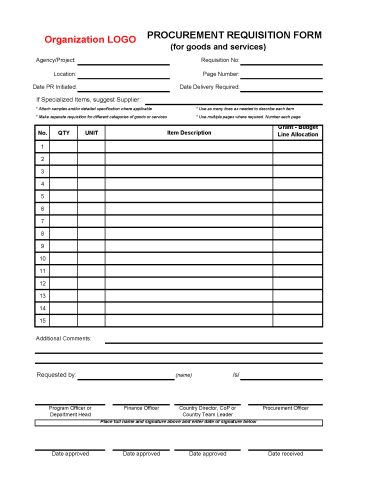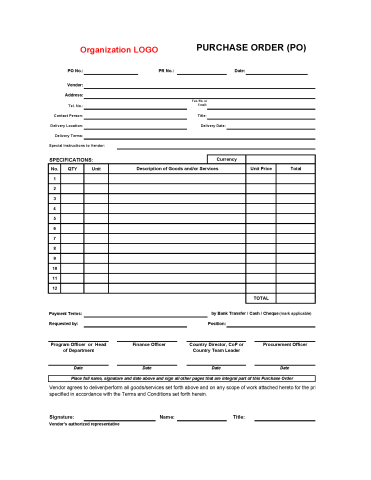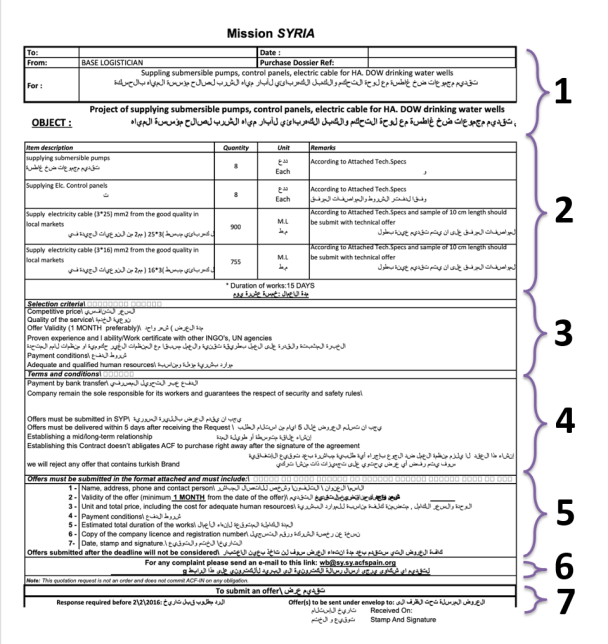A procurement procedure is an internal process established by every organisation to ensure that the purchases made are compatible with the basic principles of responsibility, accountability, transparency, equal treatment of suppliers and proportionality, while guaranteeing the best value for money. Procurement procedures ensure objectivity during the supplier awarding process. The awarding criteria themselves will need to be adapted to the context, program needs and donor regulations.
A standard procurement procedure involves the following major steps:
- Suppliers’ survey and /or publication (tender, Expression of Interest).
- Collection of technical/financial offers.
- Internal review of survey (offers analysis and comparison).
- Approval of the supplier selection.
- Review of the documentation and financial commitment authorisation.
- Publication/Communication of results.
- Order and/or contract’s signature.
- Receipt/transport of the purchase.
- Payment to the supplier (based on previously agreed conditions).
- Final update, review of purchase dossier and its archiving.
Purchases are accompanied by significant cash flows, so agencies must take into account the impact they have on local markets, and the effect they may have on the beneficiaries.
Most Common Procurement Procedures
For normal operations (not first phase of an emergency response), the procurement method is chosen based on a defined framework with value thresholds. The framework includes, as a minimum, levels for Direct Purchase, Competitive Quotations and Tendering. The levels of the thresholds are based on the context, taking into account monetary values; frequency of transactions; lead time to process the procurement and organisation’s risk tolerance. The threshold set is continuously respected throughout the normal operations and reflects donor and INGO requirements. (PARCEL Project, Procurement)
Although each organisation and/or donor use different terminology, they all share the same logic and basic principles. For the purpose of this guide the names of different procedures will be as follows:
- Direct Purchase
- Competitive, Negotiated Procedure
- Tendering
Direct Purchase or Single Quotation Procedure
The direct or single quotation procedure is the most relaxed one in terms of documentation, evaluation and requirements. Direct purchases are usually done for goods or services with a low total value. The main characteristic of direct purchasing is that the goods or services are acquired without prior comparison of prices or purchase conditions, which makes the process relatively quick and easy.
The unit or person responsible for procurement will buy from the most advantageous supplier identified in the supplier catalogue. If the ordered good or service is not listed in the supplier catalogue or is new, it is good practice to ask a supplier for an RFI that will help purchasers more accurately plan the procurement. The unit or person responsible for procurement should contact the supplier to confirm the price and assure the criteria of satisfactory quality, delivery times, competitive market prices and correspondence with the available budget.
A purchase dossier might contain:
- The fully signed Procurement Request that initiated the process.
- The Purchase Order signed by the relevant persons.
- Copy of the invoice.
- Proof of delivery of the items might include one of the following:
- Supplier’s Delivery Note.
- Internal Reception Note when delivered without supplier delivery note.
- Internal Delivery Note when delivered to the requester without supplier delivery note.
- Original invoice, ideally with some form of formal approval written on it.
Competitive, Negotiated Procedure
Comparative bidding is the process of soliciting cost/project proposals for products, services or works from “bidders". The selection criteria must be established and communicated in advance to potential bidders. For procurements of higher amounts, more information is usually required to objectively evaluate and justify cost effectiveness. A documented comparison of prices and purchase conditions should be carried out prior to the purchase itself.
Once the terms of the purchase request have been agreed, an official and detailed RFQ must be prepared in writing, which will be sent to multiple suppliers (most organisations use at least three different suppliers), or the sufficient number of candidates to ensure genuine competition. The RFQ should ideally set a date for the offer’s delivery, list the technical specifications, and detail the selection criteria that will apply to the process. In the event that the minimum number of quotes cannot be obtained, as a good practice the purchaser should attach copies of the quote requests sent to the different suppliers as evidence all efforts were taken properly. All quotations must be complete and must clearly indicate the name and address of the suppliers, as well as the offer validity.
Some agencies make exceptions in cases where a quotation from a supplier is exactly the same as a previous purchase and the supplier quotations are still valid.
|
Example: A quotation for Submersible pumps in ACF-Syria 2016.
Quotations are analysed based on the selection criteria mentioned in the RFQ and the results will be presented in a bid matrix. The supplier selection is generally the joint responsibility of person or team managing procurement and the person or team making the request for procurement.
Before the financial commitment becomes effective, some agencies choose to add an additional layer of validation, whereby the heads of the procurement and financial departments approve the purchase, certifying that both the process followed and the financial allocation are correct. In the case of contracts with a high amount, the validation of the pre-identified relevant persons is usually mandatory.
A purchase dossier ideally should contain:
- The fully signed Procurement Request that initiated the process.
- The originals of the different suppliers’ quotations received and the request for those quotations (especially if no quotes were received).
- The negotiated procedure evaluation table with all necessary validations, along with an explanatory note, if relevant.
- The PO or Contract signed by the parties.
- Copy of the invoice, ideally referencing the solicitation number or other tracking number.
- Proof of delivery of the products:
- Supplier’s Delivery Note.
- Reception Note when delivered without a supplier delivery note.
- Internal Delivery Note when delivered to the requester without a supplier delivery note.
Public/Open Tenders
Unlike the negotiated procedure where an organization recognises at least three (3) potential suppliers from whom it requests a quote, a public or open tender is the process of opening bids to the public and inviting anyone to submit an offer. Offers are evaluated by a tender evaluation committee created at the beginning of the process. It is strongly advisable that all members of the evaluation committee and the employees involved in the bidding process are obliged to understand and sign some sort of declaration of objectivity and confidentiality or a similar document.
All documents necessary for the tender must be prepared and have been verified before the start of the tender. These documents are generally sent to headquarters for approval prior to the publication of the tender. An open national tender might consist of:
- Creation of the evaluation committee.
- Definition of the supplier selection criteria.
- Tender Notice publication in the media.
- Sending the Tender Dossier/RFP to interested suppliers who have requested it.
- Complete the List of applicants and bidders.
- Evaluation of all bids received using some sort of evaluation report.
- Awarding a contract to the chosen provider and inform those not chosen.
- Signed contract.
A Purchase Dossier might include:
- Declarations of objectivity and confidentiality.
- Any waiver (ex. nationality and provenance of the goods).
- Copy of the newspaper/ website carrying the Call for Tender.
- Participation requests.
- Tender dossier.
- Opening session minutes.
- Offers received.
- Tender evaluation report with comparative table.
- Tender report.
- The HQ’s authorisation of the award.
- Signed contract and any subsequent addenda.
- Report of acceptance of goods or completion of services and/or works.
- Commercial invoice.
- Delivery notes.
- Payment.
- Payment receipt.
The tenders could have a different geographical scope, allowing only local economic operators to see and submit and offer, or allow anyone nationally or internationally to present their offer. Things to consider when selecting geographical restrictions include local economies, the efficiency in the process, ethical standards and environmental care while assuring the availability of the product/service in the terms that are needed by the organisation.
It is also possible to make tenders:
- Open - where all interested suppliers may submit a tender
- Restricted - only suppliers within a pre-defined scope or category may take part.
Setting Thresholds
The concept of "thresholds" is key to determining appropriate procedures to apply. Thresholds ensure the principle of proportionality between the purchase market cost and the level of effort required to obtaining the best purchase conditions.
Thresholds work by defining a dollar value at which higher levels of signature or approvals are required. The higher the value of the procurement, the higher the approval authority and the more detailed the procedure to be applied.
As an example, an agency may wish to set a threshold at $500 USD:
- Below $500 USD, only a local logistic officer and requester are required to sign off, and only a PO is require.
- Above $500 USD, the head of base/mission and/or the head of finance may be required, and a competitive bid may be required.
The nature and limit of each threshold will be determined by individual agencies, based on their own financial oversight needs and guided by:
- Donor regulations
- Country/national level requirements
- Internal organisational audit procedures
The level of thresholds and the required procedures should be included in each agencies' procurement manual or procurement policies.
Comparative Table Different Procedures
Following the proportionality principle, it is advised to increase the complexity of bidding and evaluation if the total amount is higher that the value of the proposed procurement.
| Direct Purchase or Single Quotation | Competitive, Negotiated Procedure | Tender Value | |
|---|---|---|---|
| Threshold: | Low value | Medium | High |
| Level of publicity: | None | Medium (min. 3 suppliers contacted) | High (publication in media, public opening of offers, public award notice) |
| Evaluation: | Light, one person | Medium (Logistician + Requester) | High (Tender Evaluation Committee, min. 3 people) |
| Documents: | Few (PR, PO, Invoice) | Medium (PR, RFQ, Quotes, Bid Analysis Table, PO, Invoice, GRN) | High (13 templates) |
| Validation: | Field level | Country Level + HQ (in some cases) | Country + HQ for Tender Dossier and supplier selection |
Bid Splitting
"Bid splitting" is the act of artificially splitting a bid among several smaller purchases instead of a single large purchase. Artificially splitting a bid within a budget is usually done to avoid a relevant procedure, and is considered a bad practice and may constitute fraud.
Bid splitting becomes fraudulent when the objective of the persons managing procurement is to apply a less restrictive procurement procedure than what best practice or agency wide procurement procedures might advise. Splitting a bid may not always be fraudulent when circumstances necessitate it for security, cost-effectiveness, and other justifiable reasons. Any decision to split a bid must be clearly explained and documented.
Donors and Grant Funds
Donors are entities, institutions or individuals that finance the projects that an organisation implements. Procurement procedures must guarantee that all goods, services and works are obtained in accordance with their procurement policies, as well as all the laws applicable to these expenses.
Any person or team responsible for procurement must be familiar with donor procurement-related regulations at all stages of the project cycle and ensure that a organisation fulfils its contractual obligations to the donor. Among other actions, the procurement unit must verify if the donor has specific rules on thresholds and procurement procedures, as well any specific regulation applicable to the acquisition of medical or agricultural products, equipment, etc.
- General regulations donors:
- Donor thresholds.
- Nationality and/or origin requirements of products.
- If donor approval is required (evaluations, audits, etc.).
- Specific regulations for specific products (medicines, medical supplies).
- Sanctions or anti-terrorism controls
- Denied entities to procure from.
- Possibility of using HPCs (Humanitarian Procurement Centres).
- Specific regulations pertaining to any agreement signed with the donor.
- Expense eligibility or contract start and end dates – allowing time enough for the procedure to take place and the goods/service to be delivered.





